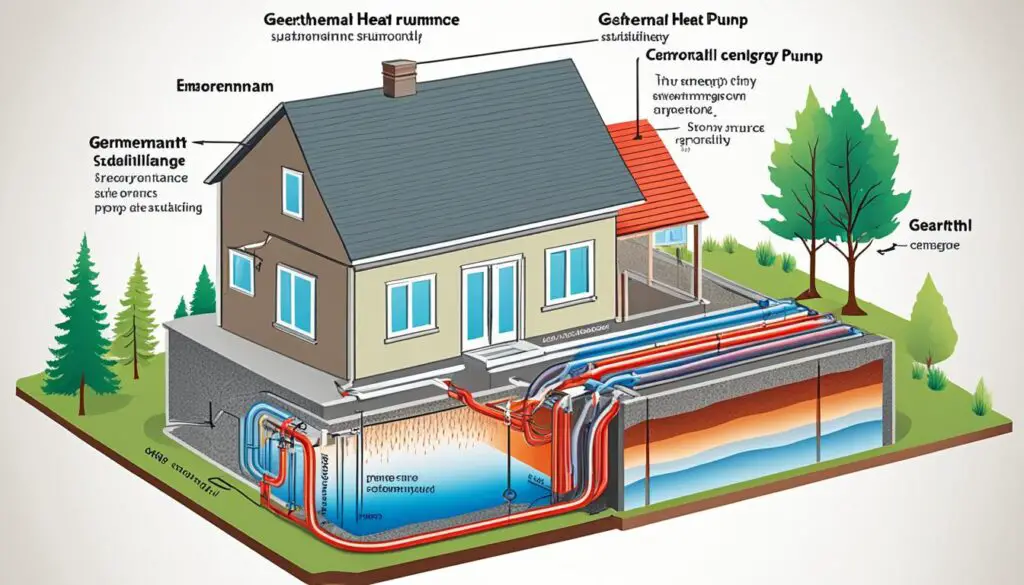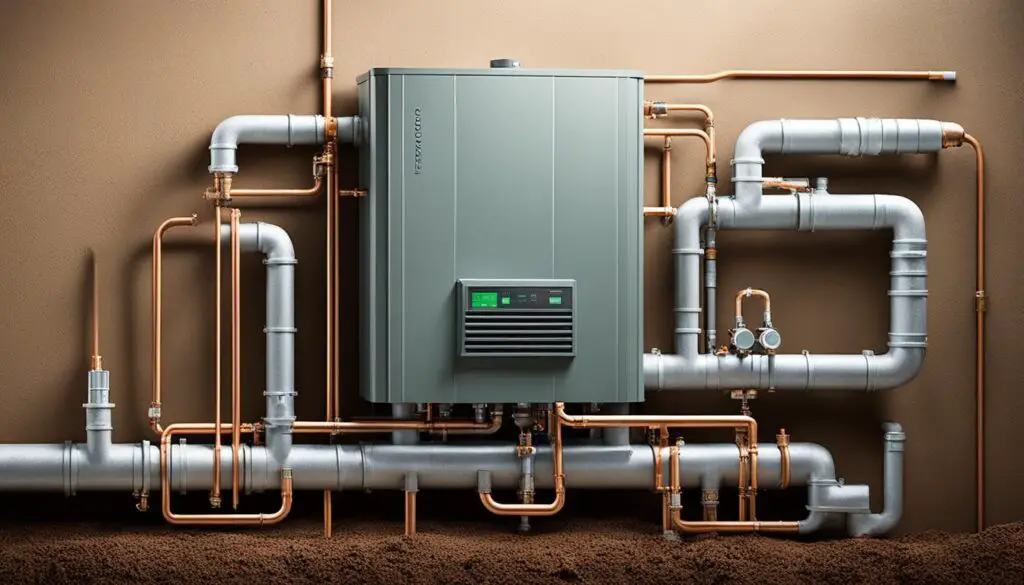Are you looking for a way to keep your home warm or cool all year? Geothermal heating systems are your answer. They use the earth’s heat to make your home comfortable, save you money, and help the environment.
Geothermal systems work differently than standard HVAC systems. They don’t use air for heat exchange. Instead, they use the earth or water’s constant temperature. This method is very efficient, saving energy and money.
Geothermal heat pumps are unique because they provide both heating and cooling. They move a refrigerant through pipes underground or in water. This transfers heat. Then, an air handler sends this air through your home.
There are many designs of geothermal heat pumps, like closed loop and open loop systems. This means there’s a type for every property and landscaping need.
Key Takeaways:
- Geothermal heating systems provide energy-efficient comfort and lower utility costs.
- They utilize the earth’s stable temperature for heat exchange, making them environmentally friendly.
- Geothermal heat pumps combine both heating and cooling capabilities into one unit.
- There are different types of geothermal heat pumps to suit various property and landscape designs.
- By opting for geothermal heating systems, you contribute to reducing your carbon footprint and enjoying sustainable home comfort.
What Is Geothermal Heat Pump and How Does It Work?
A geothermal heat pump uses the earth’s constant temperature to transfer heat. Unlike standard HVAC systems that use the air, these pumps use the ground or water. This approach makes heating and cooling more efficient and green.
In summer, the pump moves heat from inside the home to the earth outside. This cools the living area. In winter, it does the opposite, warming your home with heat from the ground. This system keeps your home comfy throughout the year.
Geothermal heat pumps combine heating and cooling in one device. This makes them more energy efficient and cuts down on maintenance needs.
This system involves a refrigerant circulating through pipes underground, known as the loop. In winter, the loop draws heat from the earth; in summer, it releases heat back. The refrigerant then goes to the indoor handler, where fans distribute the air through ducts in your home.
Geothermal heat pumps tap into the earth’s natural heat for many benefits. They are very energy-efficient and eco-friendly, cutting carbon emissions and reducing reliance on fossil fuels. They also help to lower utility bills and make your living space more comfortable and healthier.
How Geothermal Heat Pump Works:
- The geothermal heat pump exchanges heat with the ground or water.
- During the summer, it draws heat from the home and transfers it to the earth outside.
- In the winter, it draws heat from the warmer ground and brings it into the living space.
- Geothermal heat pumps combine heating and cooling systems into one unit.
- The refrigerant is pumped through an underground network of pipes.
- The refrigerant is then pumped back to the indoor air handler.
- Fans blow the heated or cooled air through a duct network.
- The conditioned air is distributed evenly throughout the home.
Geothermal heat pumps provide efficient and sustainable heating and cooling by utilizing the temperature of the earth for heat exchange. By drawing on this renewable energy source, homeowners can enjoy year-round comfort while reducing their carbon footprint. The integration of heating and cooling systems in a single unit, along with the underground network and duct network, ensures efficient and effective system operation.
Types of Geothermal Heat Pumps and Their Installation
Geothermal heat pumps are a flexible way to heat and cool homes. They work well with different home and landscape styles. There are four main types: closed loop horizontal, closed loop vertical, closed loop pond/lake, and open loop systems.
Closed Loop Horizontal
This system is a budget-friendly choice for homeowners. It puts refrigerant pipes horizontally under the yard, about 4 feet down. Many pick this method because it fits various home designs.
Closed Loop Vertical
Large geothermal setups in commercial or space-limited homes use the closed loop vertical system. It involves drilling deep into the ground. This choice can cost more upfront.
Closed Loop Pond/Lake
A closed loop pond/lake system places refrigerant loops in water, like a pond or lake. It leverages the steady water temperature. It’s a cost-effective choice for those with access to a suitable water body.
Open Loop
The open loop system uses well or surface water for heat exchange. It requires clean, constant water flow. It’s a wallet-friendly choice if you have a good water source.
Each geothermal heat pump type offers its own benefits. Think about cost, home type, and size when choosing. Pick what fits your needs and budget best.
| Type of Geothermal Heat Pump | Installation Method | Advantages |
|---|---|---|
| Closed Loop Horizontal | Laying pipes horizontally beneath the yard | Cost-effective and suitable for various designs |
| Closed Loop Vertical | Drilling deeper into the ground | Ideal for commercial buildings and limited land availability |
| Closed Loop Pond/Lake | Utilizing refrigerant loops in a body of water | Least expensive option with suitable water source |
| Open Loop | Using water from well or body of water | Affordable option with available water source |
Conclusion
Geothermal heating systems are the best choice for eco-friendly heating. They use the earth’s natural warmth to make homes cozy. This cuts down on utility bills. You can get these systems to fit any home size.
These systems stand out because they help the environment. They use the earth’s renewable energy. This lets homeowners lessen their impact on the planet. New technology has made these systems even better.
Consider geothermal heating for a long-lasting and green solution. It’s efficient, comfortable, and helps reduce carbon emissions. By choosing geothermal energy, you’re helping our planet. Join the shift towards a sustainable future.



